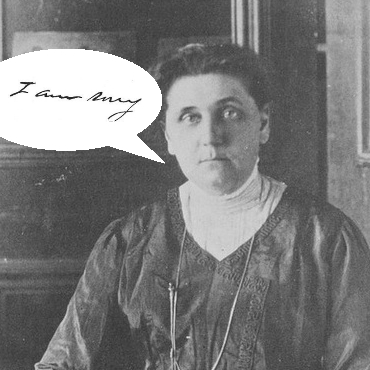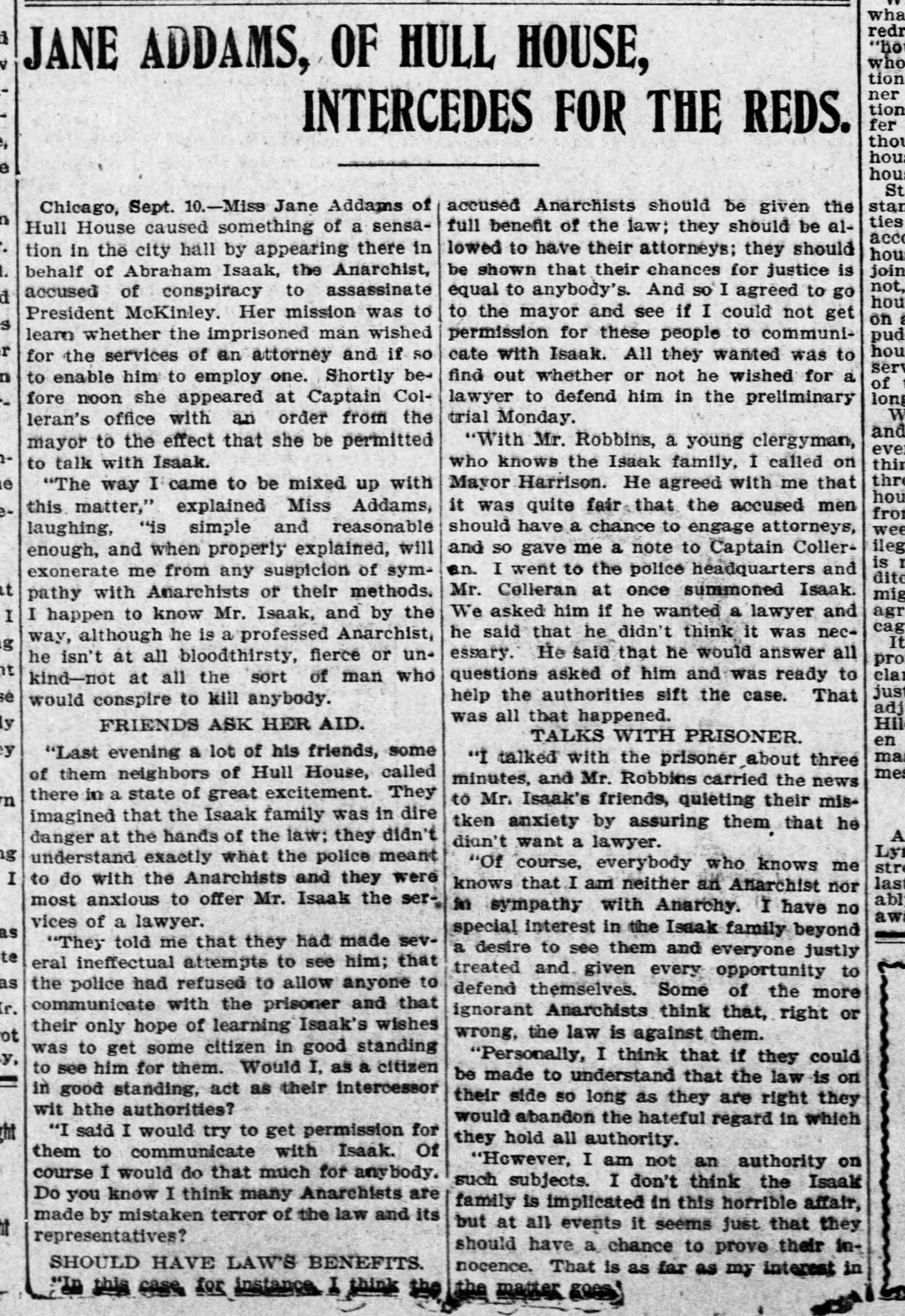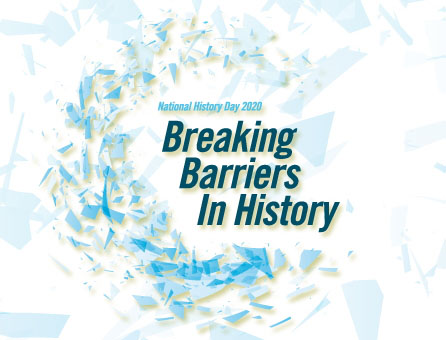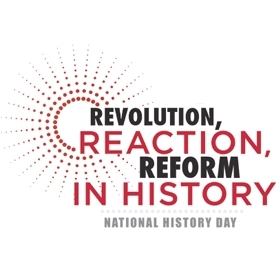Exhibits (16 total)
Reading Jane Addams's Handwriting
Cathy Moran Hajo

"The first time I tried to read Addams's adult scrawl, I tearfully despaired of ever deciphering, much less analyzing, her correspondence."
--Victoria Bissell Brown, The Education of Jane Addams (2004), 7.
Are you having trouble reading Jane Addams's handwriting? It is not easy. Here are some tips and samples to help you grow accustomed to her hand.
Lesson Plans for Middle and High School Teachers
Renee DeLora, Paige Drews, Christina Dwyer, and Michael Romano

Jane Addams was one of the most important figures of the Progressive Era. Involved with child labor, settlement houses, peace, Progressive politics, and a multitude of reforms, Addams' writings and speeches can be incorporated into a variety of lessons focusing around the Progressive Era and character education. The Jane Addams Papers Project is collaborating with teacher's education students at Ramapo College of New Jersey to develop lesson plans that utilize Addams' works as primary sources.
In an effort to continuously improve users' experience with the Jane Addams Digital Edition, we appreciate any feedback that you can provide on the lesson plans. Thank you!
Jane Addams High School AP Resources
Allie Cheff, Joe Dwyer, Cathy Moran Hajo, Juan Navarro, and Frank Romano.

Thanks to the New Jersey Council for the Humanities for supporting our work on developing high school AP resources built on the Jane Addams Digital Edition.
The grant facilitated meetings between high school teachers and the staff of the project, along with work by Ramapo College teacher's education students to develop these resources.
We hope to add more resources to this site over time. If you have suggestions for issues that you would be interested in using or if you are interested in helping develop more resources, please contact Cathy Moran Hajo (chajo@ramapo.edu).
DH Lab
One of the benefits of working on a digital edition is that we can share our data with other scholars. If you are interested in working with data about our documents, the people, organizations, or events in Addams's life or some combination of the two, please contact us and we will see how we can share our data.
Jane Addams - Hull-House Museum Educational Tools
Jane Addams - Hull-House Museum

The Jane Addams Hull-House Museum in Chicago offers a wide range of engaging educational tools and resources. These PDF-based resources are designed to stimulate thought, creativity and dialogue.
Undergraduate Assignment: Social Science Inquiry Course
Cathy Moran Hajo

In the Spring of 2020 I taught a section of Honors Social Science Inquiry at Ramapo College of New Jersey. We used the Jane Addams Digital Edition in a module that looked at tracing the history of social issues and how to interrogate a historical document.
National History Day: Communication in History
Renee DeLora

With the generous support of the New Jersey Council for the Humanities, the Jane Addams Papers and Teacher Education program at Ramapo College of New Jersey, the Jane Addams Papers Project has developed this guide for teachers and students participating in National History Day.
At the Jane Addams Papers Project, students have access to thousands of letters, telegraphs, speeches, book excerpts, and articles that were used to communicate the key ideas of Addams and the organizations she was a member of. Students can see that these methods of communication changed across the decades as technology advanced. During the 1800s, most of Jane Addams’ letters and the letters she received were handwritten, but as time progressed into the early 1900s, the majority of letters were typed. In the years leading up to World War I, Addams also began receiving more telegraphs, especially since she was often communicating with women across the United States and in Europe to organize a peace conference at The Hague. Technology has changed rapidly over the last century and students can analyze how it was changing during the early twentieth century and late nineteenth century.
In looking at Addams’ communications, students can study not only how a national organization, like the National American Woman Suffrage Association, communicated with the public, but how the women involved communicated with each other to make decisions for the organization. With local organizations spread across the country, the decisions of national organizations often seem lateral but there is a great deal of communication between individuals to make these decisions. Given Addams’ involvement in a variety of Progressive movements, not all of which were popular, people had no problem making their differing opinions clear and Addams received a great deal of positive and negative feedback in personal letters sent to her from people around the world.
Language as a method of communication can also be an area of study, as specific language was chosen to convey messages throughout these letters, speeches, etc. In addition to the final copies and articles written about many of Addams’ speeches and articles, the database also has the drafts and students can observe how Addams’ language changed over the course of her writing. In her activism, Addams targeted her speeches and writings towards specific audiences. In advocating for suffrage,. sometimes Addams focused on how the public sphere influenced the private sphere and how women needed the right to vote to be better wives and mothers. Other times, she focused on the necessity for working women and immigrant women. These choices were made for a specific reason and students can analyze how and why these messages were chosen.
Looking beyond the methods of communication used, students can also explore how Addams communicated with individuals or how Hull-House served as a tool of communication. Because the Jane Addams Digital Edition covers decades of communications, students can see the evolution of Addams’ relationships with major Progressive Era leaders. Addams was connected to some of the most important figures of the Progressive Era and had periods of frequent communication with the likes of Theodore Roosevelet, Carrie Chapman Catt, Woodrow Wilson, Alice Stone Blackwell, and many more.
In the Jane Addams Digital Edition you will find letters, speeches, articles, and other documents that illuminate this year's themes. We have highlighted a few research topics to get you started, but you can find other topics, subjects, and events that will also fit the theme.
Happy researching!
If you are a teacher and would like to provide feedback on this guide, please fill out this form so we can continue to improve the Jane Addams Digital Edition.
If you are a student and would like to provide feedback on this guide, please fill out this form. Thank you!
CREDITS
Renee DeLora
National History Day: Breaking Barriers in History
Renee DeLora

With the generous support of the New Jersey Council for the Humanities, the Jane Addams Papers and Teacher Education program at Ramapo College of New Jersey, the Jane Addams Papers Project has developed this guide for teachers and students participating in National History Day.
Looking at history through the lens of breaking barriers takes individual historical events and puts them into a broader perspective. It requires an understanding of the social and political dynamics of the time period. Jane Addams's generation of women had limited, yet unprecedented access to education, which gave them more access to professional careers. As women moved into formerly male-only spaces, they broke barriers and changed old systems into new ones. Addams founded Hull-House, helping to launch the settlement movement in the United States, which had been started by men. Additionally, Addams worked as to reform society through the woman suffrage movement, prohibition, labor activism, and efforts to solve the problem of juvenile delinquency. While these movements included both men and women, women became the leaders.
In the Jane Addams Digital Edition you will find letters, speeches, articles, and other documents that illuminate this year's themes. We have highlighted a few research topics to get you started, but you can find other topics, subjects, and events that will also fit the theme.
Happy researching!
If you are a teacher and would like to provide feedback on this guide, please fill out this form so we can continue to improve the Jane Addams Digital Edition.
If you are a student and would like to provide feedback on this guide, please fill out this form. Thank you!
National History Day: Debate and Diplomacy
Renee DeLora, Christina Dwyer, Michael Romano

With the generous support of the New Jersey Council for the Humanities, the Jane Addams Papers Project and the Teacher Education program at Ramapo College of New Jersey, the Jane Addams Papers Project has developed this guide for teachers and students participating in National History Day.
As a general theme, debate and diplomacy offers a way to analyze both domestic and international topics dealing with human relations. Political topics lend themselves well to this topic, but are not the only ones that you can work on. Jane Addams was known for her diplomatic skills in her work with the suffrage movement, city politics, social reform, and the peace movement. A leader in Progressive politics, Addams was a popular speaker who used debate to build public support for progressive reforms. Another form of debate can be found by looking at letters Addams received from people who disagreed with her ideas or suggested different solutions for problems. Good examples of Addams’ diplomacy and debates over the best course of action are found in documents on the woman suffrage movement and the peace movement.
Jane Addams used her diplomatic skills as an advocate for peace even before the outbreak of World War I, but it was in the early years of the war that she entered the debate over the United States’ role in the conflict. Addams allied with other women, both in the United States and abroad to call for a start of peace negotiations. She led the International Congress of Women held at The Hague in 1915, negotiated with world leaders, and sought a more rational, diplomacy-based means of settling national disputes. Her work helped influence the League of Nations and she was honored with the Nobel Peace Prize for it in 1931.
In the Jane Addams Digital Edition you will find letters, speeches, articles, and other documents that illuminate this year's themes. We have highlighted a few research topics to get you started, but you can find other topics, subjects, and events that will also fit the theme.
Happy researching!
Student Projects
Paige Drews

The Jane Addams Papers wants to encourage student work on Jane Addams, especially work with a digital component.
If you have created an Jane Addams-based project, let us know and we may publish it here.
Contact Cathy Moran Hajo at chajo@ramapo.edu for more details.
National History Day: Innovation in History
Paige Drews

The Jane Addams Digital Edition, in association with the New Jersey Council for the Humanities, the Jane Addams Papers Project and the Teacher Education Program at Ramapo College, invite you to use this guide when brainstorming for National History Day.
History has always provided occasions for innovation. When people wanted goods from another country, they found new, faster routes over land and water. When farmers wanted to increase production, they created efficient machines like the plow. When citizens needed to communicate across the world, telegraphs, telephones and eventually email would link them. Whatever the problem, humanity has been able to create a solution.
One of the most innovative solutions arose from the the Progressive Era of the late 1800’s and early 1900’s. People living in this time faced issues from multiple sources: rapid industrialization brought farmers and immigrants to the cities in search of work. This influx of people sent urban populations skyrocketing. People already living in cities felt pressured by all the new faces, but they were especially threatened by the arrival of immigrants. Native-born Americans eyed their new neighbors with suspicion, fearing they would take away jobs due to their willingness to work for any price. In response to the overwhelming problems of the time, the settlement movement took shape. Wealthy men and women turned houses in the poorest neighborhoods into havens for those living in cities. They provided advice and educational services for factory workers, recreation for children and social gatherings for immigrants and nonimmigrants to reconcile their differences.
Settlement houses strived to comfort and to bring hope to everyone they served, and no house accomplished this better than Jane Addams’s Hull House. Founded in 1889, Addams quickly expanded her settlement to be one of the largest in the country, totaling thirteen buildings. Each building housed new and innovative programs for poor such as soup kitchens, a public bath and extracurricular classes for neighborhood children. She continuously sought to know those she served and always made certain to put their needs first. Her pioneering spirit and creative outlook on settlements made Hull House one of the greatest innovations of the Progressive Era.
We encourage all students and teachers to look through the Jane Addams Digital Edition for documents written by Jane Addams that will aid their work.
Good luck!
National History Day: The Individual in History
Renee DeLora, Michael Romano, Christina Dwyer

With the generous support of the New Jersey Council for the Humanities, the Jane Addams Papers and Teacher Education program at Ramapo College of New Jersey, the Jane Addams Papers Project has developed this guide for teachers and students participating in National History Day.
The course of history can be dramatically changed or influenced by the actions of one person. Jane Addams stands out among Progressive Era reformers, but Addams rarely worked alone. Supported by other like-minded individuals, Addams was involved in most major reform movements of the early twentieth century. Her reputation carried a great deal of respect, so she was able to attract crowds, financial backing, and influence. Additionally, Addams’ writings inspired reformers and regular citizens. The work of Jane Addams and others improved the lives of children, workers, women, and immigrants.
In the Jane Addams Digital Edition you will find letters, speeches, articles, and other documents that illuminate this year's themes. We have highlighted a few research topics to get you started, but you can find other topics, subjects, and events that will also fit the theme.
Happy researching!
If you are a teacher and would like to provide feedback on this guide, please fill out this form so we can continue to improve the Jane Addams Digital Edition.
If you are a student and would like to provide feedback on this guide, please fill out this form. Thank you!
National History Day: Revolution, Reaction, Reform in History
Renee DeLora, Michael Romano, Christina Dwyer

With the generous support of the New Jersey Council for the Humanities, the Jane Addams Papers and Teacher Education program at Ramapo College of New Jersey, the Jane Addams Papers Project has developed this guide for teachers and students participating in National History Day.
As a major Progressive thinker and reformer, Jane Addams was involved in everything from woman suffrage to juvenile delinquency. As an intellectual revolution, the Progressive Era was a hotbed of reform and change. In working for woman suffrage, female reformers like Addams were able to advocate for social changes regarding labor, urban living, crime, and immigration. Women were able to provide a new perspective as they became increasingly political. Addams was not only a Progressive thinker, but a Progressive leader. To advocate for social change, Addams gave speeches, wrote articles, established various progressive groups, and served as an officer of multiple organizations dedicated to reform. Addams' efforts affected the masses, as hundreds, if not thousands people from all walks of life reacted to Addams' work. At times, reformers have pushed gradual and incremental change that have been enough to change the paths of history. Other times, sudden or violent events can revolutionize the way people think and behave. Real change is dependant not only on the reaction, but how civilization uses reaction to instill lasting transformation.
In the Jane Addams Digital Edition you will find letters, speeches, articles, and other documents that illuminate this year's themes. We have highlighted a few research topics to get you started, but you can find other topics, subjects, and events that will also fit the theme.
Happy researching!
National History Day: Triumph and Tragedy
Renee DeLora, Michael Romano, Christina Dwyer

With the generous support of the New Jersey Council for the Humanities, the Jane Addams Papers and Teacher Education program at Ramapo College of New Jersey, the Jane Addams Papers Project has developed this guide for teachers and students participating in National History Day.
Triumph and tragedy can be a useful theme to interpret historical events. In her work for social reform during the Progressive Era, Jane Addams witnessed tragic conditions in cities, homes, the workplace and in schools. By exposing these daily tragedies to the American public, Addams was able to successfully advocate for change. Addams spread the word using speeches, articles, and conferences to publicize the issues and get work started with like-minded activists. Some of the more important issues Addams focused on were the abolition of child labor, juvenile delinquency, social welfare, the plight of immigrants, and woman suffrage.
In the Jane Addams Digital Edition you will find letters, speeches, articles, and other documents that illuminate this year's themes. We have highlighted a few research topics to get you started, but you can find other topics, subjects, and events that will also fit the theme.
Happy researching!
If you are a teacher and would like to provide feedback on this guide, please fill out this form so we can continue to improve the Jane Addams Digital Edition.
If you are a student and would like to provide feedback on this guide, please fill out this form. Thank you!
Rediscovering Jane Addams in a Time of Crisis
MassHumanities, Rutherford Platt, Traprock Center for Peace and Justice, Jane Addams Papers Project

A daylong free public forum was held on Saturday, November 11, 2017 at Edwards Church in Northampton devoted to: “Rediscovering Jane Addams in a Time of Crisis.” Sponsored by Mass Humanities, in association with the Traprock Center for Peace and Justice and other organizations, the forum revisited the once-revered (and sometimes reviled) Jane Addams and examined how her struggles for social justice and peace continue today.
National History Day: Conflict and Compromise
Renee DeLora, Michael Romano, Christina Dwyer

With the generous support of the New Jersey Council for the Humanities, the Jane Addams Papers and Teacher Education program at Ramapo College of New Jersey, the Jane Addams Papers Project has developed this guide for teachers and students participating in National History Day.
Conflict & compromise is a central theme in interpreting historical events. Conflicts between ideologies, nations, and people are not always negative; while some can lead to war, others lead to greater understanding. Historians examine the multiple perspectives revealed in conflicts and provide a nuanced understanding of how people work through their conflicts. Compromises between groups and individuals can help avoid or settle conflicts. Sometimes compromise leads to permanent change, but other times it is only temporary.
In her work for social reform during the Progressive Era, Jane Addams knew about conflict and compromise. Reformers by nature protest conditions that they see as unjust, coming into conflict with governments, industries, and even public opinion. Addams used speeches, articles, and conferences to publicize issues and work with like-minded reformers to secure change. They had to work with legislatures, governments, and other organizations to reach compromises that turned into legislation. Some of the more important issues Addams focused on were the abolition of child labor and woman suffrage. Addams and other women activists in the U.S. and abroad mobilized to stop World War I and to create a negotiated peace. In so doing they faced accusations of unpatriotic behavior and found their ideas pushed aside.
Sometimes conflict and compromise can play out in the relationships between two people. Jane Addams and Theodore Roosevelt had an interesting relationship. Bothe were Progressive reformers with large public followings, but their ideas on many issues differed. Jane Addams' work for Roosevelt's 1913 presidential campaign, and their later opposition over World War I offer a way to interpret the theme in a more personal manner.
In the Jane Addams Digital Edition you will find letters, speeches, articles, and other documents that illuminate this year's themes. We have highlighted a few research topics to get you started, but you can find other topics, subjects, and events that will also fit the theme.
Happy researching!
If you are a teacher and would like to provide feedback on this guide, please fill out this form so we can continue to improve the Jane Addams Digital Edition.
If you are a student and would like to provide feedback on this guide, please fill out this form. Thank you!
